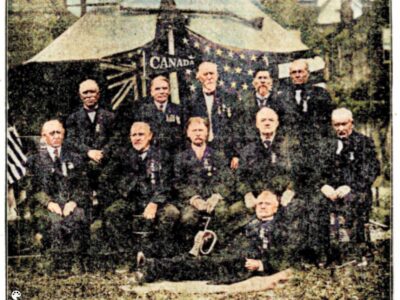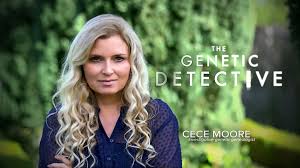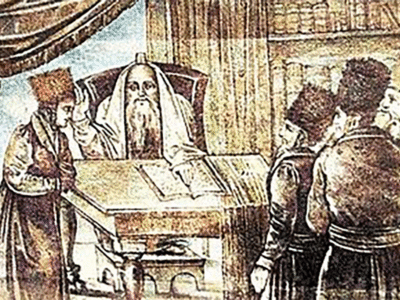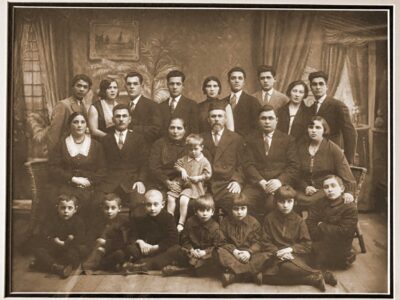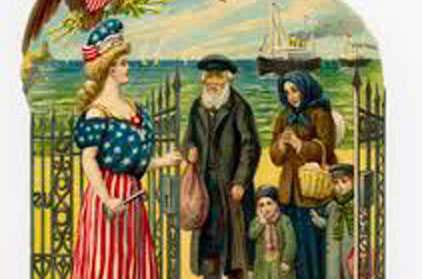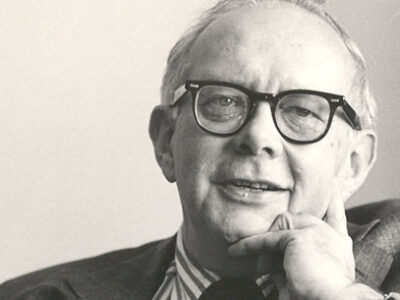Stanley Diamond, a semi-retired Montreal businessman who ran a company that manufactured decorated ceilings, has become a medical-genealogical detective in a bid to defuse what he calls a “ticking time bomb” and prevent potential suffering and death caused by thalassemia, a genetic disease.
Common among Sephardic Jews, Greeks, Italians and other Mediterranean peoples, the gene was thought not to exist among Ashkenazic Jews. But several years ago, doctors found it among members of Diamond’s family, who are Ashkenazic, and who carry a rare mutation called beta-thalassemia.
“It’s a novel mutation that has never been seen before,” said Mr. Diamond, who is president of the Jewish Genealogical Society of Montreal. “My first reaction was that I could find relatives because of this condition. Then it occurred to me that the increased incidence of intermarriage between Jews and Gentiles creates a dangerous situation for Ashkenazic Jews who are carriers and don’t know it. The greater the lack of awareness, the greater the risk of two carriers marrying and having offspring with the disease.”
Carriers are not stricken with the most potent form of the disease, but may experience a malady that is often misdiagnosed as mild chronic anemia. (To offset this, Mr. Diamond was prescribed iron pills as a child.) When two carriers marry, chances are that one in four of their children will acquire the disease, which destroys red blood cells and causes large iron deposits in the liver and other organs. The disease is always fatal, usually in the second decade of life.
Last fall, after months of letter-writing, Mr. Diamond made a circuit of Polish archives where Jewish records are kept. Generally not known for their extreme helpfulness, archival officials rolled out the red carpet to him and his translator, offering full access to usually restricted records of Jewish births, marriages and deaths from 1808 to 1939.
“For humanitarian and scientific reasons, the Polish authorities were extremely generous with their time,” he said. “They bent over backwards to ensure that I had co-operation at every level in order to do my research.”
Having previously traced his ancestry back some eight generations to 1760, Mr. Diamond’s Polish trip allowed him to uncover several lateral branches of his family tree down which the genetic trait may have descended. So far, he has determined that the gene was carried by one of his great-grandparents, Yankel and Sara (nee Nowes) Widelec, who were likely born in the town of Ostrow Mazowiecka (Ostrova) about 1825.
Two years ago, as Dr. Charles Scriver of Montreal was studying the DNA in Mr. Diamond’s blood to identify the beta-thalassemia gene, Dr. Ariella Oppenheim of Hadassah-University Hospital in Jerusalem was simultaneously involved in finding an identical gene in a Jerusalemite woman, Rita Paran, a Belarussian emigre. When Ms. Paran had given birth four years earlier, doctors suspecting Chernobyl’s disease had tested her for anemia.
“My doctor got very excited when he heard about this,” Mr. Diamond said. “He told me, ‘If we can join these two families together, it can be the subject of a medical paper.’ Well, he didn’t know who he was talking to.”
After studying Ms. Paran’s ancestry, Mr. Diamond has determined that the gene passed through her grandmother, who came from a Belarussian town within 200 km of the place where his ancestors lived. Because the disease is so rare, he is convinced that he and Ms. Paran are related.
As a routine part of his research, Mr. Diamond asks newly-discovered relatives about their medical histories. After finding a cousin of his grandmother’s in Florida, for example, Mr. Diamond phoned and asked if anyone in the family was anemic.
“She said, ‘Oh, you mean beta-thalassemia — it’s rampant in the family.’ “I screamed to my wife, ‘Bingo!’ Now I could trace it back one more generation.”
As he continues to trace distant relatives on both his and Paran’s family trees, Mr. Diamond is using electronic bulletin boards and the international network of Jewish genealogical societies to conduct a worldwide search for other Ashkenazic carriers of the gene, whose condition may or may not be known to them.
His quest, he explained, is three-fold. First, he wants to do a “geographic triangulation” of the gene to pinpoint its origin within his own family. Second, he wants to establish a computer data-base of Ashkenazic carriers of the gene around the world. “There’s such a lethargic attitude towards this disease, as far as Ashkenazim are concerned, because it’s so rare.”
And third? “Like most genealogists, I hope to find new family members,” he said. ♦
© 1997
* * *
The Polish-Jewish records indexing project & JewishGen
Seven years ago, Montreal businessman Stan Diamond arranged to index the Jewish vital records of his ancestral town of Ostrow Mazowiecka, Poland because he wanted to trace the path of a rare genetic condition called beta thalassemia within his family tree.
Diamond’s goal was medical as well as genealogical, since he sought to alert potential carriers of the beta thalassemia trait of the hazard involved. Offspring of two carriers stand a one-in-four chance of acquiring a blood disease that is always fatal, usually in the second decade of life.
After tracing his ancestry back to 1760 and finding and warning many distant relatives with the genetic trait, Diamond realized that a wider indexing project would be a boon for thousands of Jewish genealogists.
“I began to think, ‘Wouldn’t it be wonderful if we could do this for all of Poland?'” he recalled.
With the help of fellow genealogists Steven Zedeck of Nashua, NH and Michael Tobias of Glasgow, Scotland, he became coordinator of the Jewish Records Indexing Project for Poland, which to date has produced an index of 1.8 million vital Jewish records from the 19th century.
The index is easily accessible and searchable on the internet, where it is consulted by hundreds of researchers daily. (Go to the web site www.jewishgen.org and choose “data bases”.)
The project relies upon a widespread network of hundreds of volunteers whose efforts are coordinated largely over the internet.
It also employs several Russian-born data-entry clerks full-time in Warsaw. Facility with both Russian and Polish is essential for these workers because the record-books were handwritten in Polish until 1868 and in Russian cyrillac script thereafter, and are often difficult to read and translate.
A former manufacturer of decorated ceilings and the president of the Jewish Genealogical Society of Montreal, Diamond estimates that roughly 20 percent of all available Polish-Jewish records have been included in the JRI-Poland data base so far.
It is the largest and perhaps the most impressive of about 60 indexing projects accessible via JewishGen, the internet gateway to Jewish genealogy.
In its six-year existence, JewishGen has experienced explosive growth. The non-profit communal organization maintains the well-trafficked website that is a focal point for daily discussion groups and many volunteer projects, including a remarkable effort to post a growing number of searchable data bases to the net.
The Jewish Genealogical Family Finder, a computerized listing of researchers’ ancestral surnames and towns, offers a striking example of the phenomenal rise in popularity of Jewish genealogy in recent years.
In its first 14 years, the JGFF grew to include about 3,200 participants until it was taken over by JewishGen in 1996. Since then, an additional 60,000 people have contributed their research details.
“The number of people doing Jewish genealogy has unquestionably grown enormously,” said Gary Mokotoff, head of the New Jersey-based Jewish genealogical publishing house, Avotaynu Inc.
“I think the principle reason why is that people are finding that it can be done. Because their next-door neighbor is doing it or the person sitting next to them in synagogue.”
Since the advent of the internet, the annual gatherings of the genealogical community have swelled in size. Between 800 and 1,000 registrants are expected at the 22nd international conference on Jewish genealogy, scheduled at the Sheraton Center in Toronto, Canada from Sunday Aug. 4 to Friday Aug. 9 (2002).
Diamond and Mokotoff are among an illustrious roster of international speakers slated to deliver more than 150 talks at the conference. The gamut of topics ranges from the latest developments in genetics and DNA research to the newest wrinkles in the age-old pursuit of tracing the lineages of King David and the medieval sage Rashi. Subjects include how to find records in many Jewish ancestral lands, how to trace Holocaust victims, how to get best results from the Ellis Island data base of passenger arrivals to New York, how to find cousins in Israel, and much more. The conference also offers a beginner’s workshop, numerous meetings of special-interest groups, a vendors’ marketplace, and nightly screenings of roots-related video documentaries.
There’s never been a better time to be doing Jewish genealogy, thanks to the advent of the internet, the opening up of archives in Eastern Europe and other factors, Diamond commented.
“Everything used to be against us, with the whole process of writing letters and making expensive long-distance phone calls,” he said. “Now it seems all the pins are falling into place.” ♦
© 2002
And here’s another general interest story on Jewish genealogy written to help promote the 2002 conference that took place in Toronto:
When her mother died 10 years ago, Toronto resident Judi Ghert found a “treasure trove” of family letters, diaries and photographs in her closet, most dating from about 1935.
She used information from the letters to track down some long-lost relatives from whom she learned the name of an unknown great-grandfather, Joseph Kossowsky. Then she discovered that a researcher was seeking information about Kossowsky and his descendents to include on a family tree he had been researching for years — that of the Vilna Gaon, a famous 18th-century rabbi.
“It was the shock of my life to discover that my great-grandfather was the missing sibling that he had been looking for,” said Ghert, who suddenly could lay claim to a distinguished rabbinical lineage and a family tree of more than 20,000 names. “Everything I did snowballed. It just kept getting bigger and bigger. It was absolutely mind-boggling.”
Jerusalem genealogist Chaim Freedman incorporated Ghert’s “missing branch” onto the enormous family tree and published it in 1997 as Eliyahu’s Branches: The Descendants of the Vilna Gaon and His Family.
Ghert and many other genealogical enthusiasts are preparing for a five-day conference on Jewish genealogy that begins in Toronto on Sunday. Between 800 and 1,000 people are expected at the 22nd International Conference on Jewish Genealogy, which is being held at the Sheraton Centre Aug. 4 to 9. The gathering is hosted by the locally-based Jewish Genealogical Society of Canada in conjunction with the International Association of Jewish Genealogical Societies.
More than 150 talks are scheduled, many focusing on the lands where Jews have lived down the centuries — Ukraine, Lithuania, Austria-Hungary, Russia, Belarus, Spain — with a special emphasis on Poland. Guests speakers include Teresa Swiebocka, archivist of the Auschwitz-Birkenau State Museum, and Batya Unterschatz-Landsman, former director of the Israeli Search Bureau for Missing Persons. Other topics run the gamut from the ancient lineages of King David to the latest wrinkles in genetics and DNA research.
Canada is well represented with discussions of Jewish farm colonies in Saskatchewan, Jews in the armed forces during WWII and a talk by historian Irving Abella on the various waves of Jewish immigrants to Canada from preconfederate times to the present. American topics include the Ellis Island data base of passenger arrivals to New York City and how to use the US draft registration of WWI for genealogical purposes. The conference also offers a beginners’ workshop, vendors’ marketplace and a mini-festival of roots-related documentaries.
Interest in Jewish roots has grown enormously since two trend-setting books, Arthur Kurzweil’s From Generation to Generation and Dan Rottenburg’s Finding Our Fathers, launched the modern Jewish genealogical movement about 25 years ago. Whereas once a generation of Jewish immigrants seemed intent to distance themselves from their old-country roots and assimilate into modern North American society, many of their descendents now seem just as keen to remember their families’ original names, ancestral towns and history.
Today a specialized website called JewishGen (www.jewishgen.org) is the focal point for an international community of researchers. The site is home to daily discussion groups and a cornucopia of on-line resources and tools, most compiled and coordinated by volunteers. Tens of thousands of people use the site each year.
The largest and perhaps most impressive of JewishGen’s roughly 60 searchable data bases is the brainchild of Stan Diamond, a retired Montreal businessman. Known as the Jewish Records Indexing Project for Poland, it is an index of some 1.8 million 19th-century Jewish vital records — mostly births, marriages, deaths — easily searchable by surname.
Genealogy is “the only activity that cuts across every aspect of Jewish existence,” Diamond observed. “Religious and secular, rich and poor . . . even non-Jews get involved.”
Like Diamond, Toronto resident Marek Lipsztajn has been invited to give a presentation at the conference. Last year he and a friend raised the money and local interest necessary to restore a 200-year-old Jewish cemetery in Ozarkow, Poland.
Most conference participants are American, but some are coming from as far away as Europe, Israel and Australia.
Organizers recently announced that Billy Crystal, the Los Angeles-based comic, movie actor and Academy Awards host, will convey a message to participants via a representative. A genealogy enthusiast, Crystal is helping to promote a new roots-oriented project involving the Simon Wiesenthal Center’s Museum of Tolerance in Los Angeles.
Who knows? Perhaps someone may discover that Crystal is a cousin twice removed. ♦
© 2002

